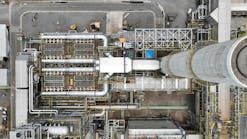European refiner squeeze seen in W. African crude changes
European refining is pivotal in “a second wave of structural changes” pummeling West African (WAF) crude oil prices in response to growing production of light oil in North America, notes a report from the Oxford Institute for Energy Studies, London.
“In a way, WAF has become the swing barrel heading into North America,” write Bassam Fattouh, the institute’s director, and Amrita Sen, chief oil analyst at Energy Aspects. Attractiveness in North America of light WAF crudes depends strongly on price differentials between West Texas Intermediate and Brent crude, they point out.
In the first wave of structural change for WAF, rising production of light crude from tight-oil plays backed out imports of WAF crude on the US Gulf Coast, which fell from a high above 1.3 million b/d in 2007 to zero at the end of last year, the analysts note. Meanwhile, growth of railroad transport between the Bakken play in North Dakota and the East Coast lowered imports of WAF there to less than 75,000 b/d from a high of 450,000 b/d in 2006.
Offsetting shrinkage of the US market for WAF crude until recently were increases in demand from new refining capacity in Asia, disruptions to supply from producers of light crude in the Middle East and Africa, and needs of European refiners to replace light, sweet crude from Libya. Now, WAF production has mostly recovered, and Asian buying has diminished.
European squeeze
A squeeze on export-dependent refiners in Europe is one of two factors Fattouh and Sen see in the current, second wave of change for WAF crude.
European refining faces growing competition from the Middle East and suffers from structural disadvantages relative to what the study authors describe as “the US and Russian refining juggernauts.”
Because Russia taxes exports of products less than crude, integrated companies tend to maximize refinery throughputs and product exports even when global refining margins narrow.
And in the US, a ban on crude exports lowers inland crude prices and encourages refinery throughput.
“US Gulf Coast refineries enjoy an implicit guaranteed minimum refining margin,” the authors say.
Russian and US exports thus have advantages in competition with the surplus light products European refiners produce while meeting regional demand for middle distillates. Furthermore, US gasoline is displacing European exports in Latin America.
This undermining of European refining economics means that a slowdown in global oil demand would take its heaviest toll on crude runs in Europe. With European and some Asian refiners as its main buyers, WAF crude thus would be most affected by the market weakness, the authors say, adding “The swings in European refining runs may imply an increased volatility in WAF crude prices.”
Canadian changes
The other dimension of the second wave of change is displacement of WAF crude from the Canadian East Coast by heavily discounted light crudes from the US.
To feed 1.3 million b/d of simple refining capacity geared to gasoline output in eastern provinces, Canada imports nearly 700,000 b/d of crude, mostly from Atlantic Basin producers, especially African.
Recently, shipments of crude by barge have increased from the US Gulf Coast to Canada, where the US crude-export ban and Jones Act shipping restrictions largely don’t apply.
US crude exports to Canada reached a record high 260,000 b/d in April and May, Fattouh and Sen report.
“The USA has captured significant market share from WAF, with the percentage of Canadian imports being met by the US surging to 50% while those from WAF dipped below 10%,” the authors write, noting that trade between the Gulf Coast and Canada depends heavily on the price spread between Brent and Louisiana Light Sweet (LLS) crudes.
Fattouh and Sen say WAF crude might be mostly backed out of North American markets by the first quarter of 2015.


